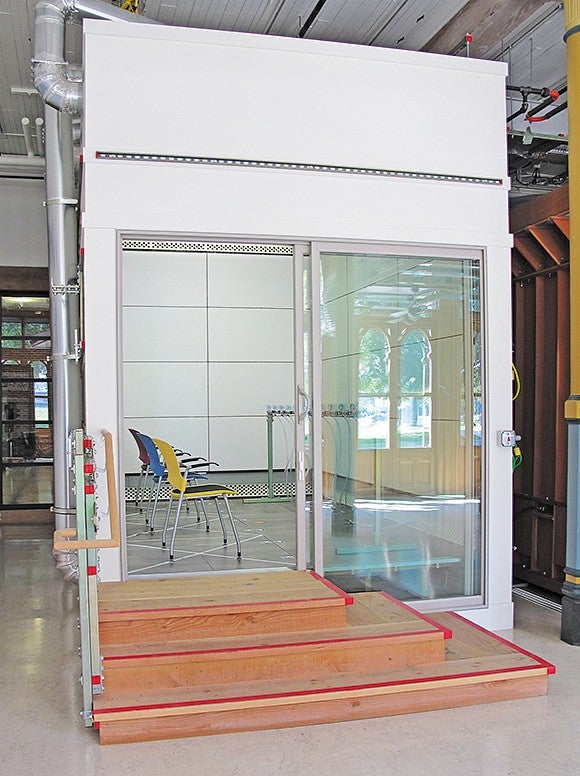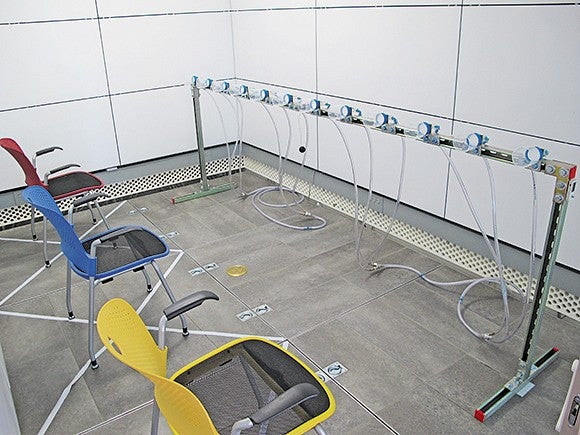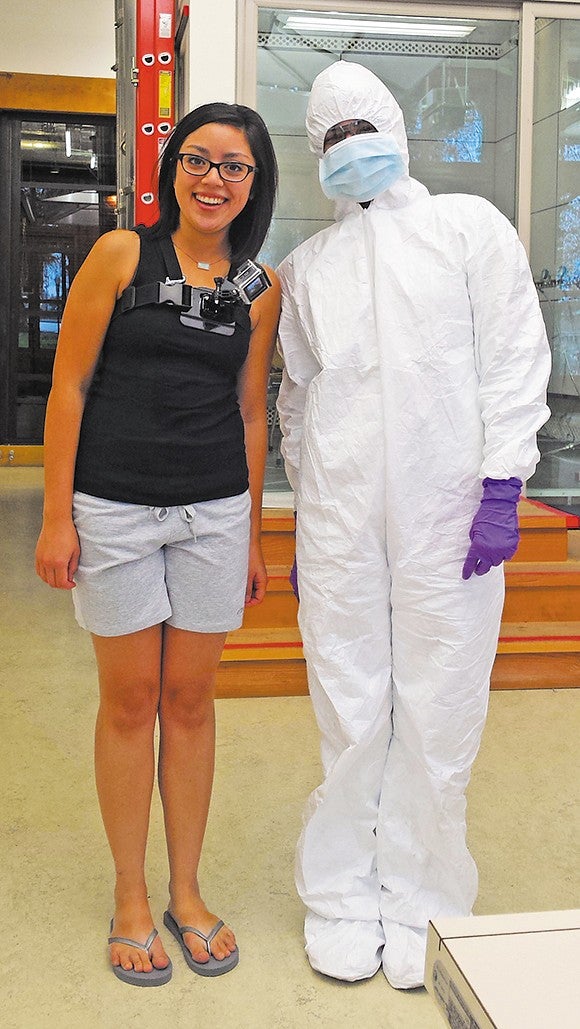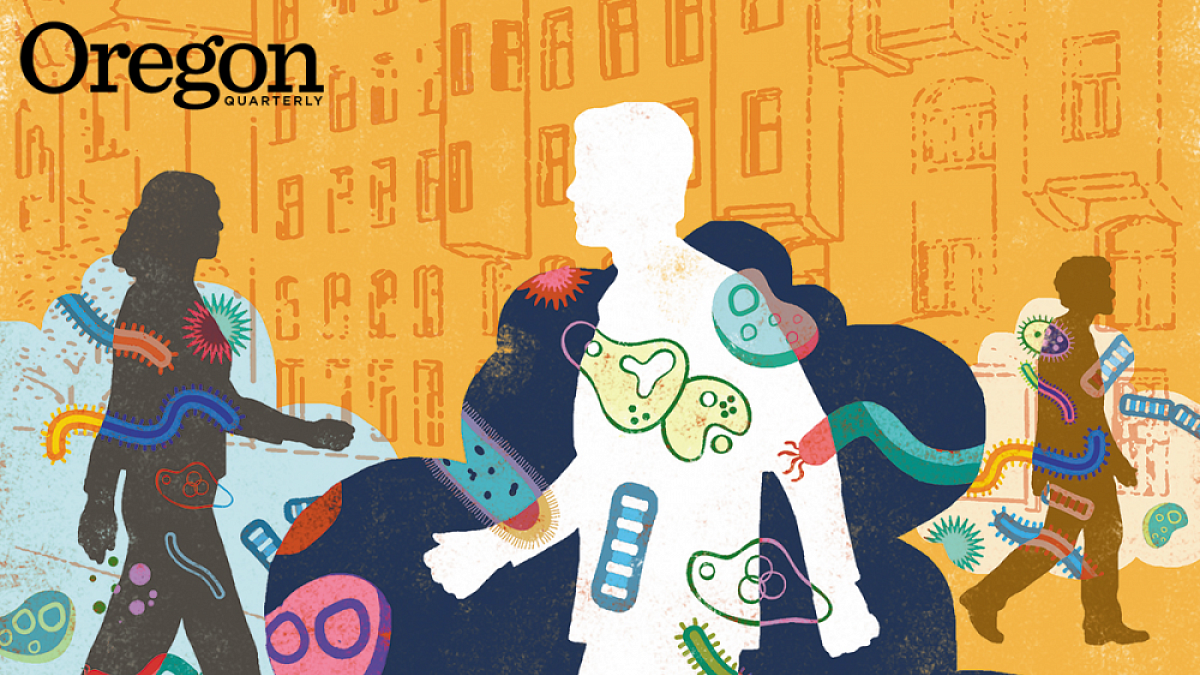Remember that “Peanuts” character perpetually engulfed in a cloud of dust?
“I have affixed to me the dirt of countless ages,” Pigpen explained. “Who am I to disturb history?”
As it turns out, Charles M. Schulz, Pigpen’s creator, was on the cutting edge of science. Even more ahead of their time were ancient East Indian mystics who spoke of an aura—healthy or unhealthy— surrounding every person.
We know now that microbial clouds composed of bacteria, fungi, algae, and viruses surround all humans—clean or dirty. We also know that bacterial cells outnumber human cells in our bodies. Every hour, humans emit a million or so biological particles that can be transferred to other individuals and indoor surfaces (outdoors they are dispersed more readily) by direct contact. “As kids, we were freaked out by cooties,” says James Meadow, a former postdoctoral researcher at the University of Oregon’s Biology and the Built Environment (BioBE) Center. “Turns out we were right. And the image of Pigpen? That turns out to be true, too. We are all spreading microbes all over the place.”
And that’s not all. Thanks to research conducted by the BioBE scientists, we now know that each of us emits a one-of-a-kind microbial cloud, consisting of trillions of microbes, into the surrounding air. “The microbes make a unique cocktail for each person,” Meadow says.

When you are attracted to someone, your microbes may be communicating. When you smell body odor, good or bad, you are inhaling some of that person’s microbial cloud. When a family moves into a new home, it takes less than a day for the new house to look, microbially, just like the old one. “And when you stay in a hotel room, you change the microbiome in a matter of hours,” Meadow says.
The BioBE Center is an interdisciplinary collaboration between biology researchers and architects from the university’s Energy Studies in Buildings Laboratory (ESBL) who are working together to better understand how the indoor environment is shaped by humans—and how inhabiting buildings and other indoor spaces influences our health and well-being. Funded by the Alfred P. Sloan Foundation, the center is headed by Jessica Green, associate professor of biology—also a member of the UO’s Institute for Ecology and Evolution—and Kevin Van Den Wymelenberg, associate professor of architecture and director of the ESBL.
The ESBL has a natural connection to the BioBE, Van Den Wymelenberg says. “We need to understand the synergies between biology and the built environment so that we can create energy design strategies that are also healthy for people, and that add to health, comfort, and productivity.” With the growth of energy-efficient buildings, indoor environments have become a hot topic. Getting a handle on how to make them healthy requires understanding what types of microbes humans emit into their surroundings and how the design, construction, and ventilation of any built environment—whether it’s a home, office building, medical center, or vehicle—affects its microbial population.
“The indoor environment influences not just health, but also our comfort and happiness,” says postdoctoral researcher Roxana Hickey. “We are beginning to understand that we don’t live in a bubble. What we are exposed to has a big impact on the bacteria and fungi in our bodies. Our goal is to understand the feedback loop between microbial communities and health and well-being.”
Measuring the Cloud
It’s not easy to measure the human microbial cloud because we are not the only microbe-rich occupants of buildings. We share that attribute with the dust in the corners. When we walk around, the dust gets stirred up and our microbes get mixed together. “We’re like an 18-wheeler going down a dusty road,” says Meadow. So the BioBE researchers needed to find a place where they could measure the human microbial cloud in a dust-free setting.
The research took place in a tightly controlled climate chamber (affectionately known as the pickle box) at the UO’s White Stag Block in Portland. The chamber, with radiant-heated walls, ceilings, and floors, is primarily used by architects who seek to understand comfort and energy design in buildings.
The BioBE researchers cleaned and sterilized the chamber. Each test subject sat alone in the room in a disinfected chair, dressed in a brand-new tank top and shorts, surrounded by air filters that were about a meter away. After several hours, the scientists collected the microbes filtered from the air and extracted and sequenced their DNA. This allowed them to see exactly what types of bacteria and fungi were present in each person’s “atmosphere.”

While all the clouds contained common bacteria such as Streptococcus, which is emitted in our breath, and Staphylococcus and Corynebacterium, which are found on our skin, researchers found that women’s clouds contained bacteria that are specific to the human vagina, such as Lactobacillus. “Some microbes, mostly genitourinary-tract microbes, are only found when women are present,” Hickey says. “People think that’s gross, but these microbes are found in healthy humans, and it is nothing to be alarmed about.”
Each person’s cloud was identifiable for hours after the person had left the chamber. “It’s like a fingerprint,” says Van Den Wymelenberg.
“Our study suggests that bacterial emissions from a relatively inactive person, sitting at a desk for instance, have a strong influence on the bacteria circulating in an enclosed space and on surrounding surfaces,” the researchers reported in the journal Plos One. “Our results confirm that an occupied space is microbially distinct from an unoccupied one, and demonstrate for the first time that individuals release their own personalized microbial cloud.”
The researchers were so surprised by the strength of the results that they ran the experiment again. All in all, they generated more than 14 million sequences representing thousands of types of bacteria found in the samples of dust and air from the chamber. “The second time was even more clean, and very controlled,” Meadow says. “It was pretty astounding.”
Thinking Inside the Box
Ninety-three percent.
That’s how much of their lives most Americans spend indoors. According to a study sponsored by the Environmental Protection Agency, we spend 87 percent of our time in buildings and an additional 6 percent in some sort of enclosed vehicle. That doesn’t leave a lot of time for breathing fresh air.
This is a relatively new phenomenon. We lived as hunter-gatherers for thousands of years and then transitioned to living in agrarian societies, interacting with our natural surroundings and other species in numerous ways. Then came the Industrial Revolution, followed by the technology revolution, and the dynamics of our lives changed radically. “In the scale of human history, this is a fascinating experiment,” Van Den Wymelenberg says. “What we’re seeing is that there are a lot more people with food and atmospheric allergies.”

It’s not just that we are inside. It’s the buildings themselves. As concerns about energy consumption have grown ever greater, buildings have been constructed ever more tightly, to the point where the indoor atmosphere is often inhospitable to human health. “People thought that mechanical heating systems and fluorescent light bulbs could solve all our energy problems,” says Van Den Wymelenberg, “but we need to use strategies that are also healthy for people.” We know now that the more bacteria we have around us, the better. It turns out that it’s the process of trying to ultrasterilize everything that does us the most harm. “There has been a paradigm shift,” Hickey says. “Most microbes are not pathogens. We need them for our survival and our health. We need to learn how to enrich our environments to retain good microbes, through design, lighting, and the materials we use.”
As a result, she says, the thought behind architectural design is changing from “Does it look good?” to “Will it create comfort, health, and happiness?”
And that’s the focus of the BioBE Center.
Fresh Is Best
BioBE researchers hope to pinpoint how ventilation strategies, human occupancy patterns, and different types of surfaces affect indoor air quality and the composition of indoor microbial communities. Their first big study took place in the UO’s Lillis Hall. A 10-member team of biologists and architects investigated the microbes found in 155 rooms in the building, using specially filtered vacuum cleaners to collect dust in offices, classrooms, hallways, bathrooms, and storage closets. “The study showed how architectural features and operational systems can change microbes,” Meadow says. “We found that natural ventilation can drastically change—for the better—the microbes inside of buildings.”
Lillis was a perfect study site because half of it is naturally ventilated and the other half uses an HVAC system. The HVAC side was found to have many more human-related microbes, and as might be expected, the rooms that are ventilated with windows have higher amounts of microbes, fungi, and bacteria from the outdoors. Different types of surfaces tended to have concentrations of different microbes, with desks collecting mostly microbes found on skin, chairs having more gut microbes, floors having mostly soil microbes, and walls mostly air microbes.
As might be expected, restrooms contained bacterial communities that were highly distinct from other rooms. Within offices, the source of ventilation air had the greatest effect on bacterial community structure. “This was not a surprise, ” Van Den Wymelenberg says, “but what was troublesome was that even with one of the very best mechanical ventilation systems, which Lillis has, there was a higher incidence of human-related bacteria and microbes on that side.”
Dissecting Dust Bunnies
Postdoctoral research associate Erica Hartmann studies the microbial composition of dust, particularly how it relates to human health. “Clearly, there are bad things about dust, such as allergies and asthma provoked by mold, but there are also protective health benefits,” she says. For instance, children who live in a house that is on or near a farm where livestock animals are raised, or who have a dog in the house, are less likely to develop allergies or asthma, she says. “We don’t know if it is because of the dust from the animals, the soil, or some other factor.”
Her studies are focused on how the use of antimicrobial chemicals found in soap, toothpaste, paints, carpeting, clothes, bedding, cutting boards, flooring, and other materials contributes to the growth of antibiotic resistance in dust microbes.

“We use these products everywhere,” she notes. “What are they doing in the dust? How do microbes respond to these chemicals?” She has collected dust in one office building in Eugene (with more to come), analyzing its chemical content and how various microbes are reacting to the chemicals in the dust. The final results are not in, but she did find both antimicrobials and antibiotic-resistant microbes in the dust. However, it is not new for dust microbes to have antibiotic resistance, she says. “That’s not just from humans. Our goal is to establish a baseline for what is normal, and see where things are abnormal.”
She also hopes to determine whether bacteria in dust that contains high levels of antimicrobial chemicals have developed genes that make them resistant to the antimicrobial cleaning products, or to antibiotics we use to treat infections.
“There are so many health implications worldwide,” Hartmann says. “If we can control the indoor microbiome using good design and maintenance practices, that would be huge.”
Light and Clouds
A third area of BioBE study is the interaction between dust and light. How are bacteria and fungi affected by ultraviolet radiation? The researchers are studying the effects of creating high levels of daylight inside buildings and have found that it makes a very positive impact on our microbial environment, which in turn affects our physical and psychological health. “Our advice is to put the people who are working in offices all day in natural light,’” Van Den Wymelenberg says.
To see how dust reacts to sunlight, they created what they call “daylight boxes” (miniature rooms) and put dust in them. The boxes were put on the fourth floor of the UO’s Pacific Hall, where they could capture sunlight. The study will help show the impact of solar exposure on the populations of microbes, fungi, and bacterial compounds in the dust.
Another climate chamber study is also underway, in which researchers will examine the clouds of three people at a time instead of one. The goal is to determine how far each person’s microbial cloud extends when they are sitting still and whether the clouds have a spatial structure. They will also experiment with different air circulation patterns and temperatures to see how the cloud is affected.
The BioBE is also collaborating with the ESBL in conducting a study (funded by the Environmental Protection Agency) in which they are investigating the impacts of weatherization on indoor air quality. The study will sample homes, before and after weatherization, in Portland and Bend. “What does weatherization do to the indoor microbiome?” Van Den Wymelenberg asks. “It’s not all good or all bad. There can be benefits to a controlled ventilation system. But we also need to educate people about the value of fresh air.”
None of this work would be possible without the huge advances that have taken place in DNA sequencing. “It took us 10 years to sequence the human genome, but now we can sequence DNA in an afternoon,” says Meadow, who is now working as a data scientist at Phylagen, a company that performs microbiome analysis for the commercial, food processing, health care, and transportation industries. “We are at a time when the technology is exploding, and we can ask questions that were impossible to ask.
“We have been looking miles and miles into space and down deep in the ocean for new discoveries,” he adds, “but now we can look at things we have been carrying around throughout human evolution. There is so much we can learn about ourselves.”
—By Rosemary Howe Camozzi
Rosemary Howe Camozzi, BA ’96, is a former senior writer and editor for OQ.


